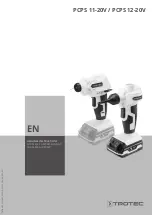
17
E
NGL
IS
H
SAFETY PRECAUTIONS FOR COMPRESSORS
9. REPLACEMENT PARTS.
When servicing, use only identical replacement
parts and fasteners recommended by us.
10. USERS
must comply with the safety warnings and all other instructions
in this manual. Keep it available for use by everyone assigned to use this
equipment.
1. TANK SAFETY VALVE:
This valve prevents damage to the air receiver if
a malfunction in the compressor pump occurs. It is factory pre-set at a limit
Doing
so will automatically void your warranty.
2. PRESSURE SWITCH:
The air pressure switch is factory pre-set for
optimum performance. Do not bypass or remove this switch. An air pressure
3. MOTOR AND COMPRESSOR PUMP:
Air compressors get hot during
operation. Do not touch the motor, discharge tubing, or compressor while it
is running. The compressor turns itself on automatically while the power is
connected.
4. AIR TANK:
Over-pressurizing the air receiver, piping or tank could cause
it to explode or burst. To protect from over-pressurizing, the compressor
is equipped with a factory preset safety valve. Do not remove, make
adjustments to or substitutions for this valve. Perform a test of the valve
from time to time: pull the ring on the valve to make sure that it operates
freely. If the valve does not operate freely, replace it before further use.
Never weld to, drill into, or change the air receiver in any way.
5. TAMPERING:
If any of the components above are found to have been
changed or tampered with, the warranty will be made void. When servicing,
we recommend using only identical replacement parts and any replacement
1. COMPRESSED AIR FROM THIS UNIT MAY CONTAIN CARBON
MONOXIDE.
The air produced is neither suitable for breathing nor food
processing.
2. AIR ONLY:
Use this compressor for compressing air only. Do not compress
other gases.
3. BREATHING PROTECTION:
Always use a respirator when spraying paint
or chemicals.
4. MAINTAIN TOOLS WITH CARE.
Keep tools clean for better and safer
performance. Follow instructions for lubricating and changing accessories.
Keep compressor dry, clean and free from oil and grease.
5. NEVER USE THIS EQUIPMENT
if it is leaking air; has missing or damaged
parts, guards, or shields; or requires repair. Make sure all screws and caps
are securely tightened.
6. DO NOT USE THE AIR HOSE
to move the compressor. Release the
pressure in the storage tank before moving.
7. DO NOT ATTEMPT ANY MAINTENANCE OR ADJUSTMENT
with the
compressor in operation, the power connected, or air under pressure in the
system.
8. CHECK FOR DAMAGED PARTS.
Make frequent inspections for the
correct function of components and safety mechanism.
SAFETY PRECAUTIONS FOR COMPRESSOR
COMPONENTS
that is too high may cause serious damage to equipment or personal injury.







































